Traditional Gujarati Kadhi With Mango (Fajeto) is a comforting and flavorful Indian delicacy that's both sweet and mildly spiced. This summer favorite is made with creamy yogurt, besan (chickpea flour), ripe mango pulp, and a handful of everyday Indian spices. Ready in just 30 minutes, this vegetarian and gluten-free dish pairs beautifully with steamed rice-or enjoy it as a warm, tangy soup. Adding mangoes takes classic Gujarati Kadhi to a whole new level of delicious!

Jump to:
What Is Gujarati Kadhi - Fajeto
Just as South Indians enjoy Vendakkai Mor Kuzhambu and Sindhis relish their tangy Sindhi Tomato Kadhi, Gujaratis have their own regional recipe called Fajeto-a sweet and tangy mango kadhi made with yogurt (or buttermilk), besan (chickpea flour), and ripe mango pulp or mango seed (gotlu).
This unique Gujarati ripe mango kadhi is light, mildly spiced, and typically made during mango season-often on the same day aamras is prepared. That's because Fajeto is traditionally made using the leftover pulp from mango seeds after extracting the juice for aamras. It's a beautiful blend of sweet, tangy, and savory flavors.
Keri No Fajeto
Fajeto is also referred to as Keri no Fajeto or Ras no Fajeto in Gujarati. It's a ripe mango curry recipe that makes delicious use of seasonal fruit and reflects the Gujarati philosophy of minimizing food waste. The ripe mango gives it a vibrant golden color and fruity sweetness, which is balanced by the tartness of yogurt and the warmth of a simple ghee tempering made with mustard seeds, cumin seeds, curry leaves, and dry red chilies.
Fajeto is often enjoyed with hot steamed rice and is considered a comfort food in many Gujarati households-especially during the summer months when yogurt-based dishes are favored for their cooling properties.
We love making recipes with mangoes in our home, especially when they're in season! If you're as mango-obsessed as we are, here are some delicious mango recipes you might want to try next: Mango Mastani, Mango Phirni, Mango Cranachan, Mango Rose Lassi, Mango Avocado Smoothie, and Mango Peach Popsicles.
A Unique Sweet and Savory Ripe Mango Curry
Whether you're exploring regional Indian curries, looking for easy Gujarati vegetarian recipes, or want to try a sweet and savory Indian dish, Fajeto is a must-make! This recipe of dahi kadhi doesn't include pakoras (unlike Punjabi kadhi), and is much lighter and mildly sweet thanks to the addition of mangoes.
Fajeto a besan-based kadhi recipe without lentils or vegetables, and its simplicity makes it ideal for weeknight meals or summer thalis. The mango and yogurt combination makes this recipe of kadhi refreshing, satisfying, and unique.
The Origins of Gujarati Mango Kadhi
Gujarati kadhi recipe beautifully showcases the resourcefulness in Indian cooking. After making aamras, the mango pulp is typically removed, leaving some fruit behind on the seed and skin. Instead of throwing these leftovers away, Gujaratis traditionally rinse them in water to extract every bit of flavor.
This mango-infused water becomes the flavorful base for Fajeto. Yogurt, besan, and spices are then added, transforming what would have been waste into a fragrant, nourishing dish that highlights the essence of seasonal eating and zero-waste cooking.
Difference Between Punjabi and Gujarati Kadhi
Punjabi Kadhi and Gujarati Kadhi may look similar, but they're quite different in flavor and preparation:
- 🥣 Punjabi Kadhi is thick, bold, and spicy. It's often made with a generous amount of besan (gram flour), includes deep-fried pakoras (fritters), and uses more robust spices. It's usually served hot with rice or roti and feels hearty and indulgent.
- 🌼 Gujarati Kadhi, on the other hand, is thinner, lighter, and has a distinctive sweet-tangy flavor. Made with yogurt, besan, and minimal spices, it often includes a bit of jaggery or sugar to balance the sourness of the yogurt. It's soothing, mildly spiced, and typically served with steamed rice.
In short, Punjabi kadhi is spicy and rich, while Gujju kadhi recipe is light, sweet, and comforting.
Why Make It
- 🧑🍳 No elaborate cooking process - easy and fuss-free one-pot meal
- 🌱 Vegetarian, nut-free, soy-free, and gluten-free
- ⏱️ Ready in just 30 minutes
- 🥣 A light stew made without lentils or vegetables
- ♻️ Sustainable - a smart way to reduce waste by using leftover mango seeds and peels
- 🥭 A unique savory dish made with ripe mangoes
- 🍲 Enjoy it warm as a comforting soup or serve it with steamed rice as a side
🧾 Ingredients Needed
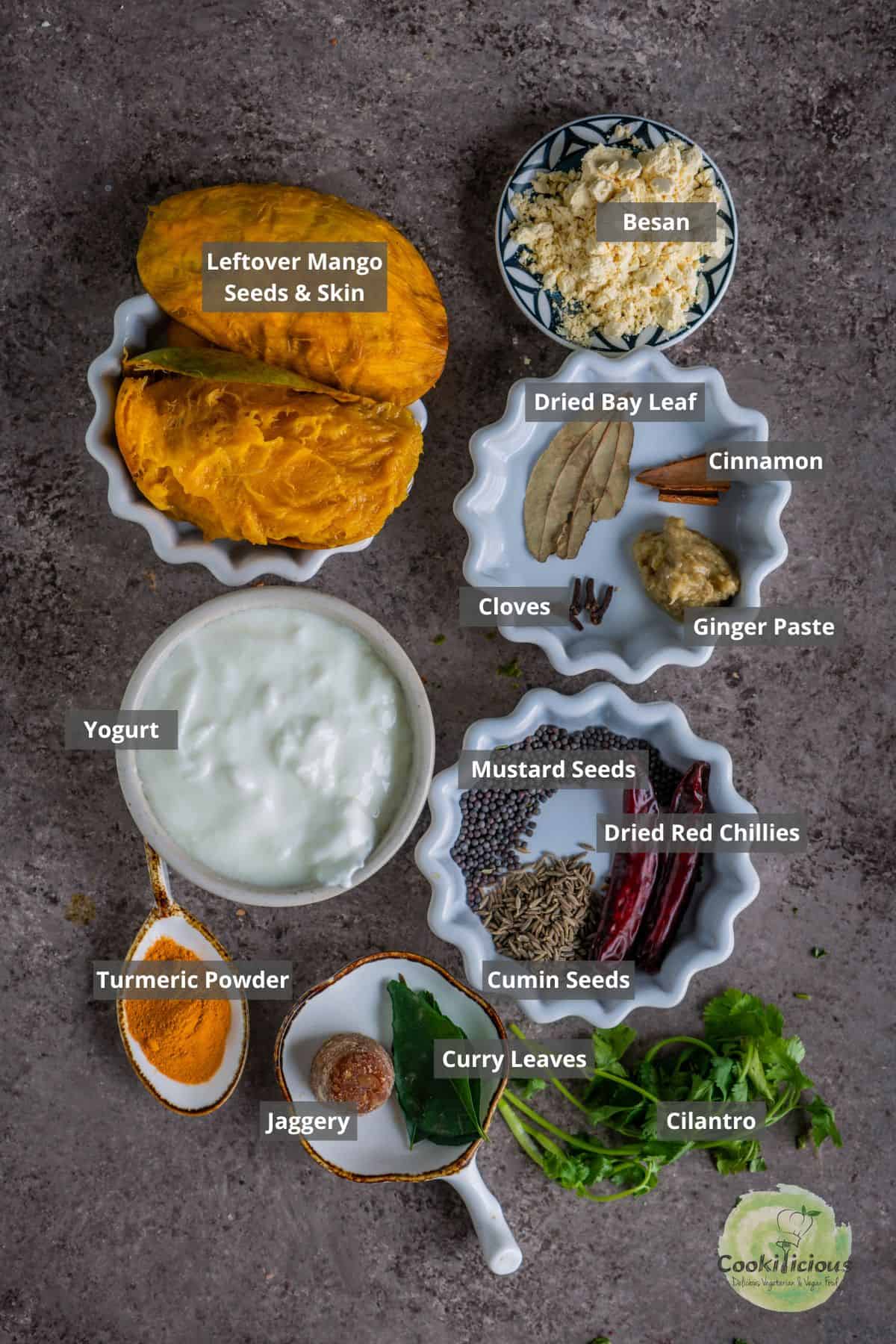
🥭 Mangoes
Use any sweet variety of mango-like Alphonso, Kesar, or Ataulfo to make this aamras kadhi. Traditionally, Fajeto is made using the leftover mango seed (gotlu) and skin after preparing aamras.
Alternative: Use homemade thick mango pulp or blend 1-2 ripe mangoes to get the required pulp if mango seeds aren't available.
🥛 Yogurt
This is the base of the khatti meethi kadhi, providing a creamy, tangy flavor. Use full-fat sour yogurt if possible. Homemade dahi or even Greek yogurt works well; just be sure to dilute and whisk it until smooth to achieve the desired consistency.
Pro Tip: The yogurt's tartness balances beautifully with the sweetness of mango and jaggery.
🌿 Spices & Seasoning
To make an authentic Gujarati-style yellow kadhi, you'll need the following spices: mustard seeds, cumin seeds, Dried red chilies (can be swapped with green chilies if preferred), turmeric powder, cloves, cinnamon stick, and dried bay leaf. These warm spices give Mango Fajeto its signature flavor and depth.
🌱 Herbs & Aromatics
Ginger paste - for a fresh, slightly spicy kick, curry leaves - essential in Gujarati cooking, and cilantro (coriander leaves) - adds a burst of freshness at the end. These aromatics elevate the dish and bring in an authentic Gujarati touch.
🌾 Besan (chickpea flour or gram flour)
Besan thickens the kadhi and gives it a smooth, velvety texture. It also helps prevent the yogurt from curdling while cooking. This is a key ingredient in most Indian kadhis.
🍯 Sweetener
To achieve the classic khatti-meethi (sweet and sour) Gujarati flavor, adding a sweetener is essential. Jaggery is most commonly used, but the quantity can be adjusted based on the sweetness of the mango and the tartness of the yogurt.
Alternatives: Sugar or brown sugar also work well to balance the sourness of the yogurt and the sweetness of the mango.
🧈 Ghee or Oil
Traditionally, the tempering (tadka) for Mango Fajeto is done in ghee, which enhances the flavor, adds richness, and imparts the signature aroma that defines authentic Gujarati khatti meethi kadhi.
How To Make It 🔪
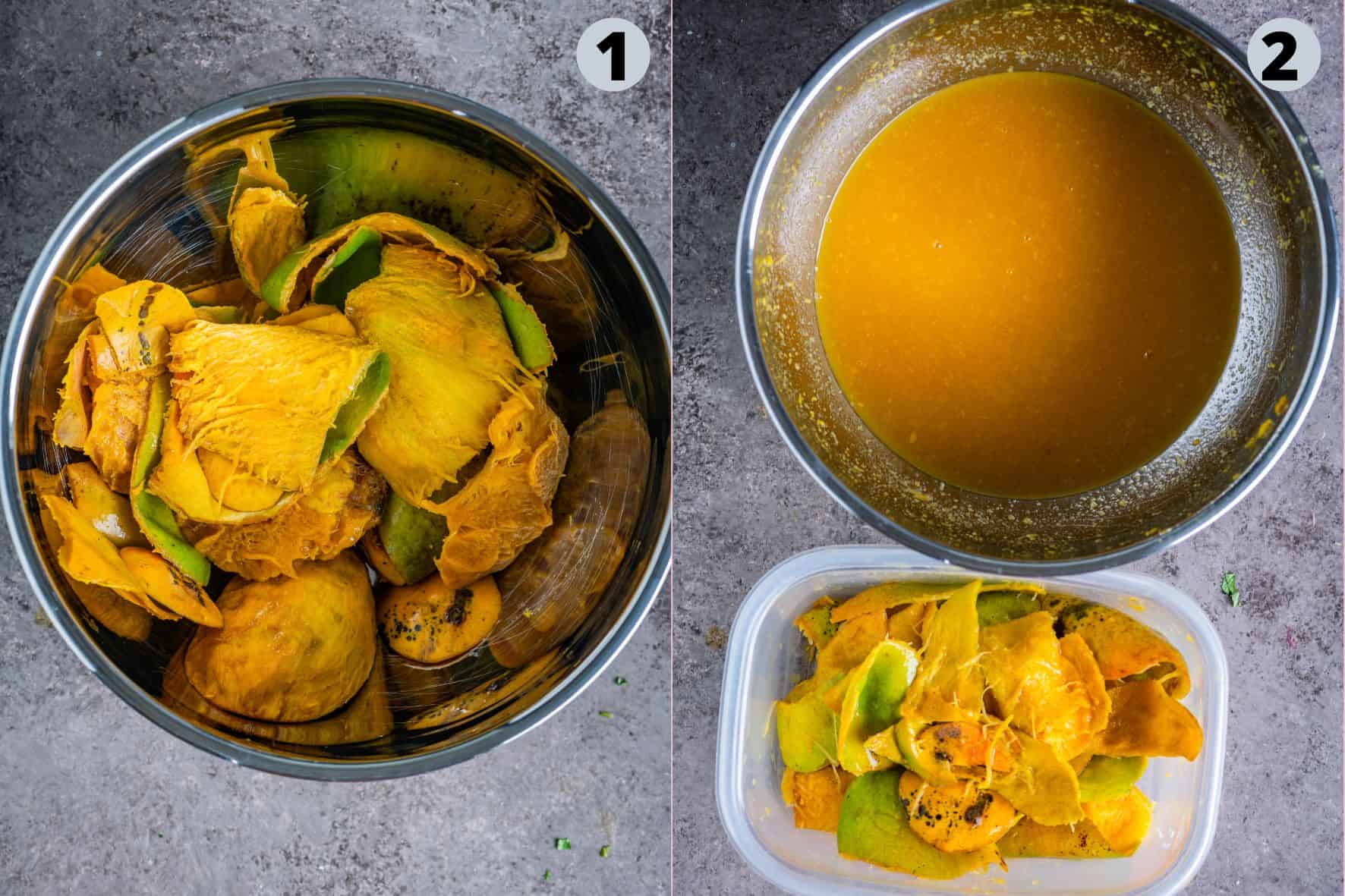
- Scoop out the mango pulp and set it aside. Use the leftover skin and seeds (gotlu)-don't discard them just yet! Transfer them to a mixing bowl.
- Add water to the bowl and use your hands to squeeze out any remaining mango juice. Then discard the skins, but feel free to leave the seeds in-they add depth of flavor and authenticity to the kadhi.
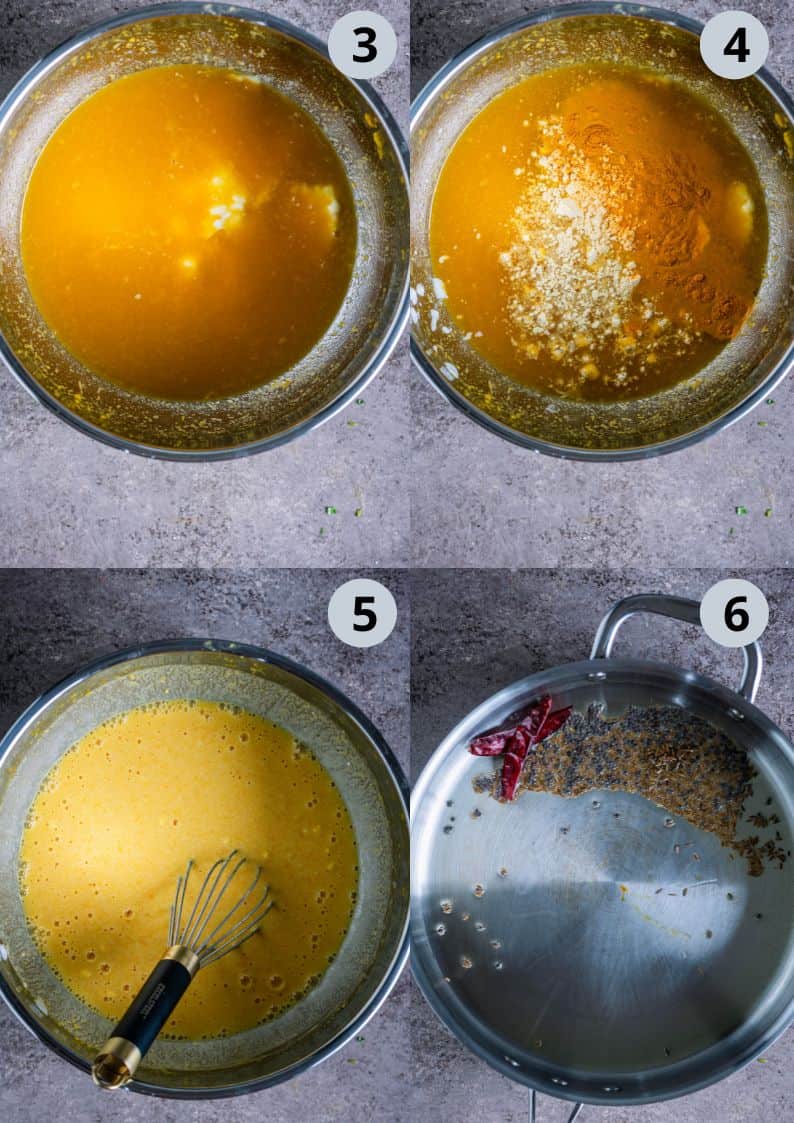
- Add yogurt to the bowl. Make sure the yogurt is at room temperature-cold dahi can cause splitting or curdling when heated.
- Mix in besan, turmeric powder, and salt. These will help thicken the kadhi and add flavor.
- Whisk the mixture thoroughly until it's smooth and lump-free. You can also use a hand blender or a mixer grinder for ease. 👉 Chef Tip: Strain the mixture if needed for an ultra-smooth and silky kadhi base.
- Heat ghee in a pan and add mustard seeds and cumin seeds. Once they begin to crackle, add dried red chillies for a mild heat and smokiness.
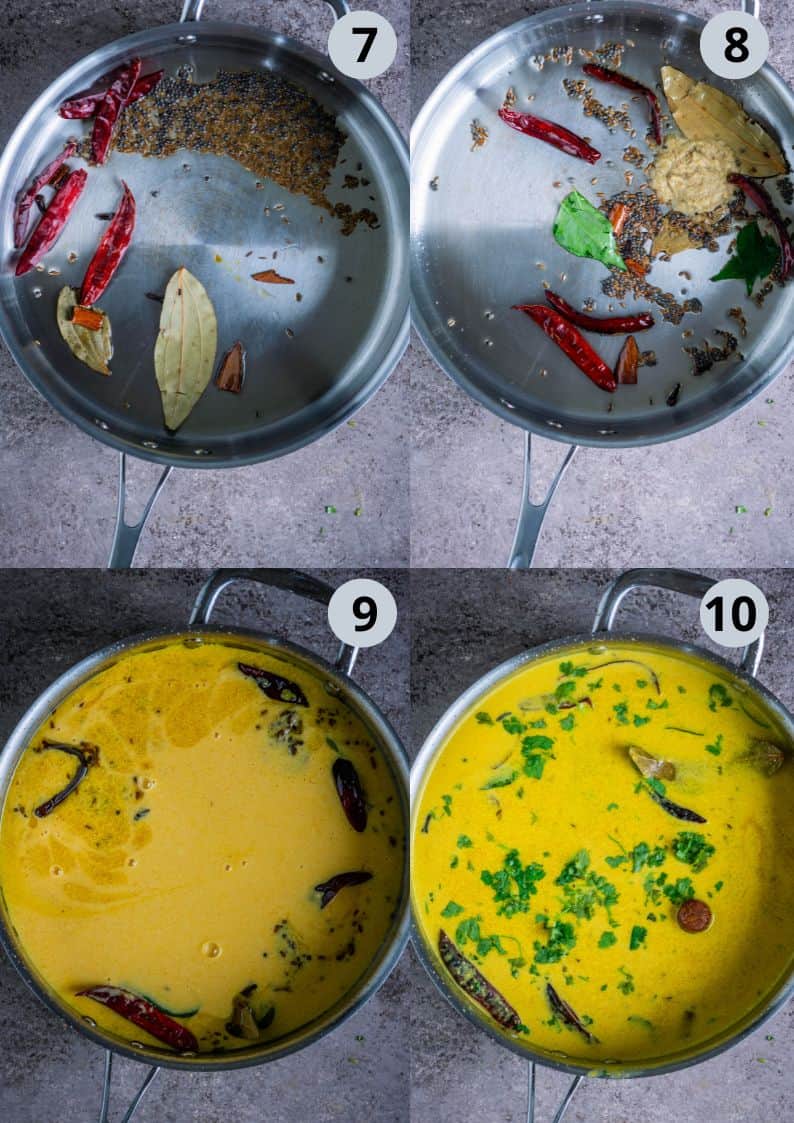
- Add whole spices-cloves, cinnamon stick, and dried bay leaf. Let them release their aroma in the hot ghee.
- Stir in ginger paste and fresh curry leaves to enhance the flavor and add a traditional Gujarati touch.
- Reduce the flame, and slowly pour the mango-yogurt mixture into the pan. Bring it to a gentle boil. If using, add the mango seeds (guthliya) at this stage. Stir the yogurt mixture continuously and then let it simmer on low-medium heat for 6-8 minutes, until it thickens slightly. 👉 Chef Tip: If the kadhi feels too thin, mix ½ tablespoon besan with a little water and stir it in to help reach the right consistency.
- Add chopped cilantro and jaggery. Adjust salt if needed and turn off the flame once the jaggery fully dissolves. 👉 Chef Tip: Taste to ensure the besan is fully cooked-there should be no raw smell. If needed, simmer for a few more minutes. To make the meethi kadhi more tangy, add a splash of lemon juice before serving.
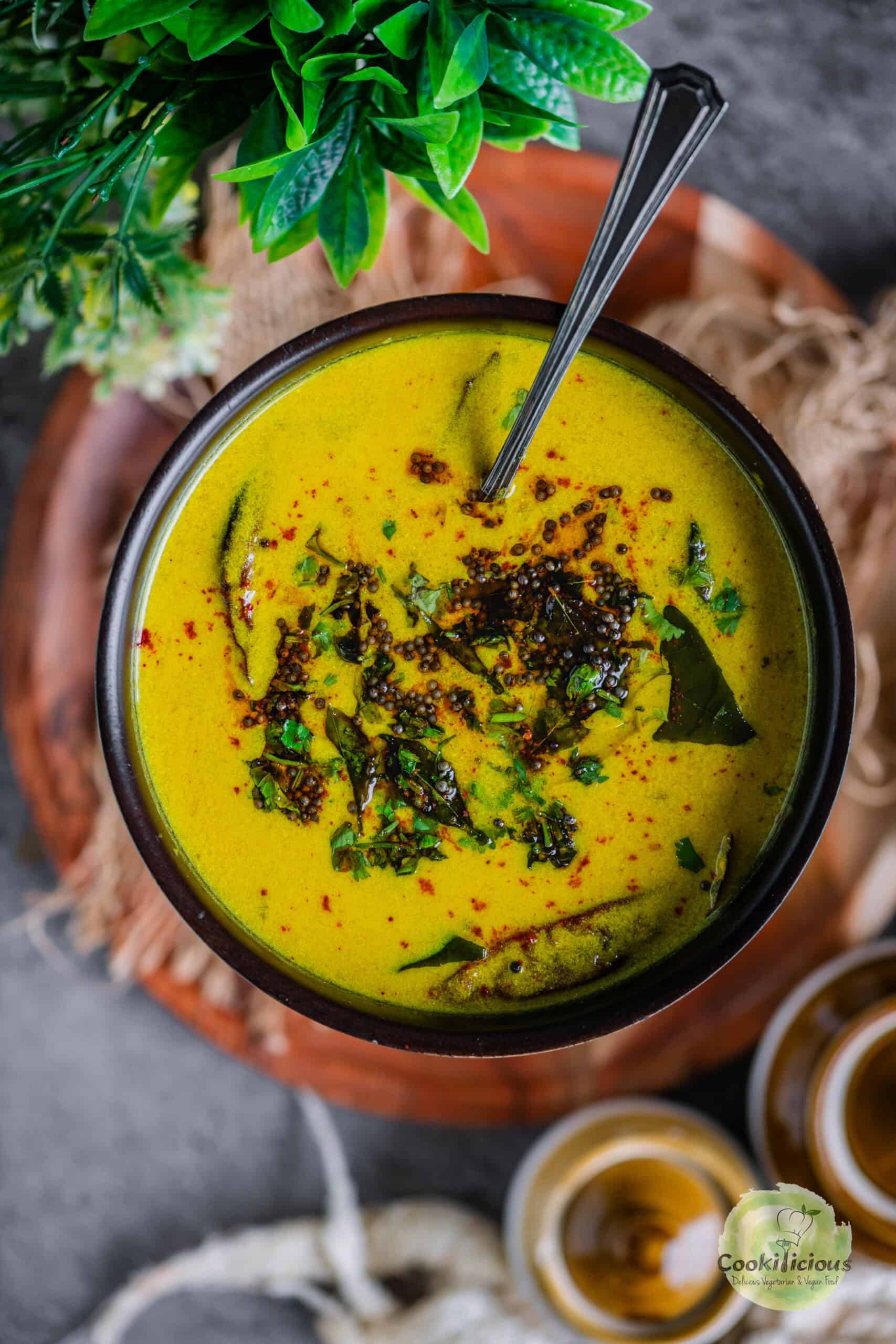
🍽 Serving Suggestions
Fajeto is incredibly versatile and can be enjoyed in many delicious ways:
- Drizzle some ghee on top and serve hot with steamed rice (Kadhi Chawal), jeera rice, roti, bajra roti, or plain Khichdi (Kadhi Khichdi). Add a side of papad, pickle, and Koshimbir (Indian salad) for a complete, comforting meal.
- You can also enjoy this Gujarati curry as a soup or savory beverage-served hot for comfort or chilled for a refreshing twist. Either way, it's soothing and satisfying!
- For a fun twist, add some fried pakoras or crispy boondi just before serving to give your Gujarati ripe mango kadhi a delightful texture and flavor boost.
Gujarati Meethi Kadhi, or Fajeto, is the ultimate comfort food-perfect for days when you crave something warm, homely, and nourishing. It's versatile enough to enjoy for lunch or dinner, and makes a great addition to family brunches, potlucks, or weekend get-togethers. Fajeto is also lunchbox-friendly when paired with rice, making it ideal for a wholesome meal on the go. Traditionally, it's commonly served during Indian festivals, weddings, and special occasions.
Hosting a summer party? Serve Fajeto warm or at room temperature in shot glasses as a savory welcome drink-a fun and creative way to introduce your guests to authentic Gujarati flavors!
Celebrate mango season with a festive Gujarati Mango Thali featuring comforting Fajeto, sweet Keri no Ras, Patra, flavorful Aloo ki Sabzi, poori, creamy Shrikhand, and crunchy Farsaan. Complete the meal with a fresh salad and crispy papad for a perfect balance of sweet, tangy, and savory flavors-ideal for summer lunches or family gatherings.
What to serve with Gujarati Kadhi
Fajeto pairs beautifully with a variety of traditional Gujarati dishes. One of the most beloved combinations is Fajeto with Fafda, a classic festive favorite. It also complements simple pulao dishes like Matar Pulao, or Paneer Pulav perfectly.
For a wholesome meal, serve it alongside dry sabzis and stir-fries such as Batata nu Shaak, Kurkuri Bhindi, Aloo Methi Fry, or legume-based dishes like Moong Dal ki Sabzi, or Matki Usal and Chickpeas Stir-Fry. Together, these create a flavorful and satisfying Gujarati spread.
If you love trying out different dishes from the Indian cuisine, then check out these recipes - Bafauri, Sultani Dal, Ammini Kozhakattai, Nimona Matar, Shahjahani Dal, Paruppu Sevai, Shahi Tendli, Himachali Chana Madra, Mushroom Kalan, and Jhajhariya.
💭 Priya's Recipe Tips
For a Jain-friendly Gujarati Kadhi, skip the ginger. To make kadhi without yogurt or besan, try my Sindhi Tomato Kadhi or Vendakkai Mor Kuzhambu recipes. If your yogurt isn't sour enough, leave it at room temperature for a few hours or add a tablespoon of sour cream. You could also use Ayran which is a sour Turkish yogurt drink. For extra flavor, add methi seeds, onions, and garlic during tempering. Leftover plain Gujarati kadhi can be transformed into Fajeto by simply adding mango pulp.
FAQs 📖
You can absolutely make plain Gujarati kadhi without mangoes and still enjoy its signature sweet-tangy flavor. Simply skip the mango pulp or seed and follow the same method. To maintain the traditional mildly sweet taste, add more jaggery or sugar to balance the sourness of the yogurt. Note that without mango and turmeric powder, the kadhi will have a more white or pale cream color instead of the usual golden yellow. It's still just as comforting and delicious!
To make a delicious vegan Gujarati kadhi, simply replace regular yogurt with plain, unsweetened plant-based yogurt such as coconut milk yogurt, almond yogurt, or cashew yogurt. Just be sure not to boil the mixture, as vegan yogurts tend to curdle when exposed to high heat. Gently heat and simmer instead. For the Gujarati kadhi tadka (tempering), swap traditional ghee with vegan ghee or any neutral cooking oil. The result is a comforting, plant-based version of Gujarati yogurt curry-light, tangy, and full of flavor!
While traditional Gujarati meethi kadhi is typically made without any vegetables, you can easily customize it by adding mild, soft vegetables for extra nutrition and texture. Vegetables like drumsticks (moringa), sweet corn, bhindi (okra), or spinach work well and absorb the flavors of the kadhi beautifully. Add them after the tempering and allow them to cook in the kadhi until tender.
That said, it's more common to serve Gujarati kadhi with a sabzi (vegetable side dish) rather than cook the vegetables directly in the kadhi. Both approaches work, depending on your preference!
Split kadhi looks like small white flecks of yogurt floating in a watery base-similar to curdled milk in cheese making. To avoid this, always use room-temperature yogurt and mango pulp (never chilled). Ensure there are no lumps in the yogurt-besan mixture. Cook it on low to medium heat, stirring continuously until it comes to a gentle boil. Adding besan (chickpea flour) helps stabilize the yogurt and prevent curdling.
If your kadhi does split, don't worry! Add 4-5 ice cubes to cool it down slightly, then remove whole spices like cloves, bay leaf, and cinnamon. Blend the mixture with a tablespoon of besan until smooth, then return it to the pan and cook on low heat while stirring. It will come back together-this is a tried-and-tested tip from my Gujarati friend's mom!
Yes, you can use ready mango pulp if fresh ripe mangoes aren't available. Use thick mango pulp-either frozen or canned works well. However, avoid using mango juice or raw green mangoes, as they won't give the authentic flavor or texture of traditional Fajeto.
If you're using store-bought canned mango pulp, keep in mind that it's often quite sweet. In that case, use only ½ cup and adjust the jaggery or sugar in the Gujarati Kadhi recipe accordingly. Also, make sure the pulp is smooth and not fibrous-strain it before adding to the mango curry for the best texture.
Since Gujarati Kadhi contains yogurt, it's best consumed within 2-3 days when stored in the refrigerator in an airtight container. If you'd like to store it for longer, let it cool completely, then transfer it to a freezer-safe container and freeze for up to 4-6 weeks. When reheating, add a splash of water to adjust the consistency, and warm it gently over low heat to preserve the flavor and texture.
Yes, you can easily make Gujarati Mango Kadhi (Fajeto) in the Instant Pot. Start by using the Sauté mode to temper the spices, then add the mango-yogurt-besan mixture and stir well. Press Cancel, close the lid, and choose either Soup mode on High Pressure for 5 minutes, or select Pressure Cook mode on Low Pressure for 9-10 minutes.
Once the cooking cycle is complete and the pot beeps, allow the pressure to naturally release for 10 minutes, then manually release any remaining pressure. Open the lid, stir the curry, adjust the consistency if needed, and finish with fresh cilantro on top.
More Indian Stews
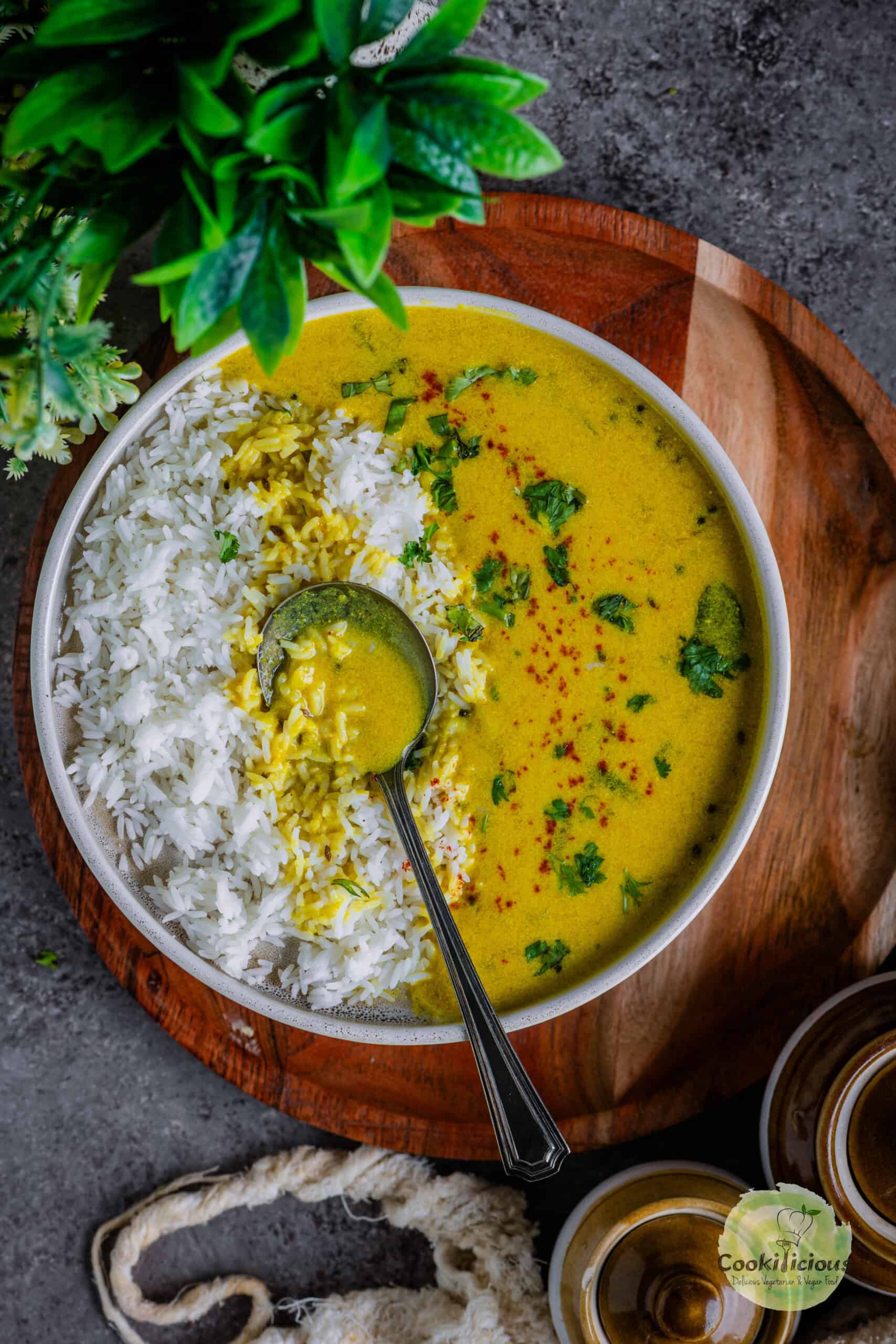
⭐️ Subscribe to the Cookilicious Newsletter and receive new recipes straight to your inbox! You'll receive my FREE Vegan Beginner's guide as a gift. Ready to elevate your cooking game? Purchase my Cookbook - The Essential Vegan Indian Cookbook today!
Recipe 📖

Traditional Gujarati Kadhi With Mango (Fajeto)
Equipment
- 1 pan
Ingredients
- 5 skin and seed of mangoes
- 3 cups water
- 1 cup yogurt
- salt
- 1 tablespoon besan
- 1 teaspoon turmeric powder
- 1 tablespoon olive oil
- 1-2 dried bay leaf
- 1 cinnamon stick
- 4 cloves
- ½ tablespoon ginger paste
- 5-6 curry leaves
- 1 teaspoon cumin seeds
- 1 teaspoon mustard seeds
- 4-5 dried red chillies
- 1 tablespoon jaggery powder or sugar or tamarind
- 2 tablespoon cilantro
Instructions
- Scoop out the mango pulp and set it aside. Use the leftover skin and seeds (gotlu)-don't discard them just yet! Transfer them to a mixing bowl.
- Add water to the bowl and use your hands to squeeze out any remaining mango juice. Then discard the skins, but feel free to leave the seeds in-they add depth of flavor and authenticity to the kadhi.
- Add yogurt to the bowl. Make sure the yogurt is at room temperature-cold dahi can cause splitting or curdling when heated.
- Mix in besan, turmeric powder, and salt. These will help thicken the kadhi and add flavor.
- Whisk the mixture thoroughly until it's smooth and lump-free. You can also use a hand blender or a mixer grinder for ease. 👉 Chef Tip: Strain the mixture if needed for an ultra-smooth and silky kadhi base.
- Heat ghee in a pan and add mustard seeds and cumin seeds. Once they begin to crackle, add dried red chillies for a mild heat and smokiness.
- Add whole spices-cloves, cinnamon stick, and dried bay leaf. Let them release their aroma in the hot ghee.
- Stir in ginger paste and fresh curry leaves to enhance the flavor and add a traditional Gujarati touch.
- Reduce the flame, and slowly pour the mango-yogurt mixture into the pan. Bring it to a gentle boil. If using, add the mango seeds (guthliya) at this stage. Stir continuously and then let it simmer on low-medium heat for 6-8 minutes, until it thickens slightly. 👉 Chef Tip: If the kadhi feels too thin, mix ½ tablespoon besan with a little water and stir it in to help reach the right consistency.
- Add chopped cilantro and jaggery. Adjust salt if needed and turn off the flame once the jaggery fully dissolves. 👉 Chef Tip: Taste to ensure the besan is fully cooked-there should be no raw smell. If needed, simmer for a few more minutes. To make the meethi kadhi more tangy, add a splash of lemon juice before serving. Drizzle some ghee on top and serve hot with steamed rice (Kadhi Chawal), roti, bajra roti, or plain Khichdi (Kadhi Khichdi).

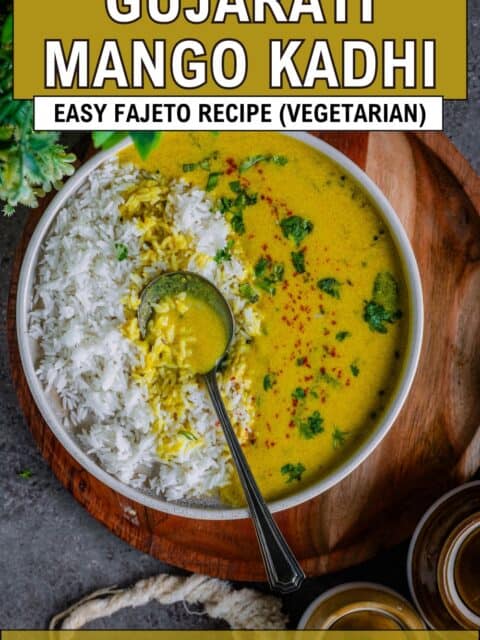
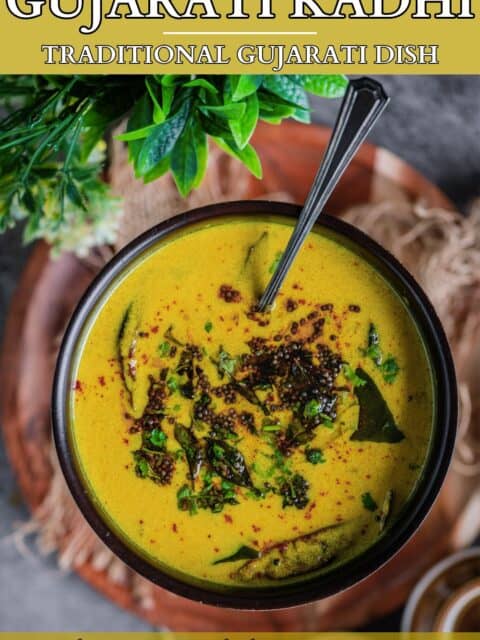
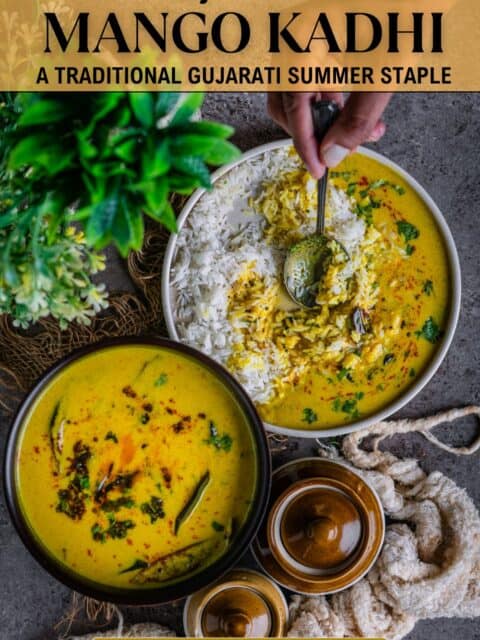
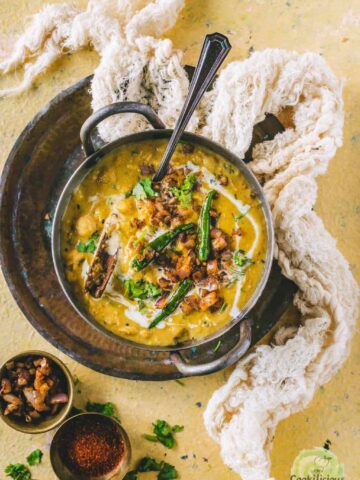
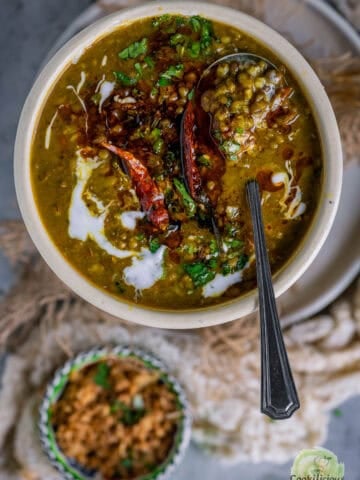
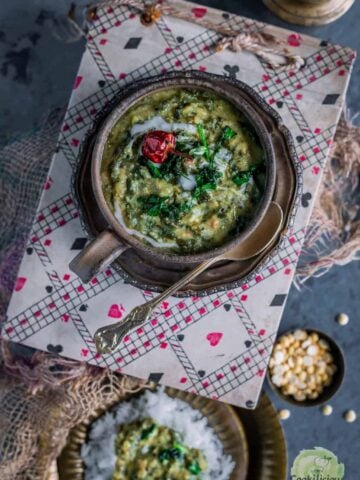
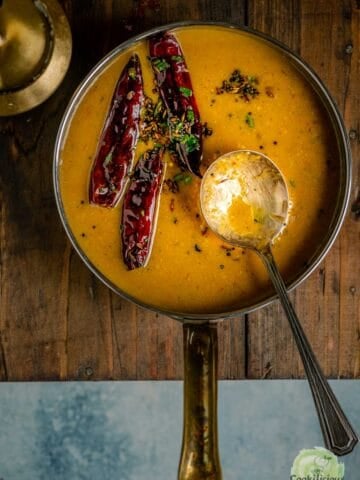
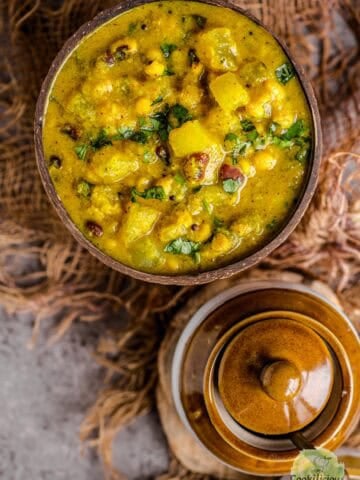
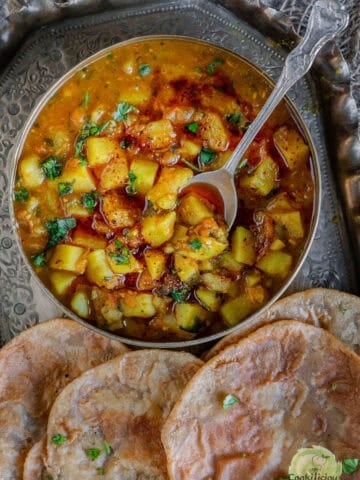


Leave a Reply